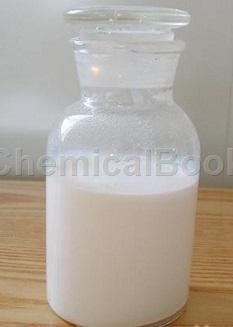Background and overview[1] [4]
A type of synthetic latex, produced by adding an appropriate amount of acrylic acid during the emulsion polymerization of styrene and butadiene. It appears as a white, slightly blue-fluorescent emulsion liquid with a relative density of 0.97 to 1.02. Its performance is basically the same as that of conventional styrene-butadiene latex. Due to the introduction of a small amount of carboxyl groups into the latex molecules, there is a wetting effect between the latex particles and the paper sheet and other components in the coating, thereby enhancing the affinity and fluidity of the coating, making it more suitable as a coating adhesive in the paper industry. It has good film-forming properties and mechanical stability, and can be added directly to the coating without aggregation. Increasing the dosage will not cause roll sticking during the drying and calendering processes. The processed coated paper has good ink brightness, coating strength and smoothness. The acrylic acid content in latex accounts for about 1% to 6%. This product is prone to change color and turn yellow when exposed to moisture, heat and ultraviolet light.
Carboxyl styrene-butadiene latex is a copolymer produced through emulsion polymerization of butadiene, styrene, a small amount of carboxylic acid and other additives. It is a milky white water dispersion with blue-violet luster. Carboxylated styrene butadiene latex has the advantages of high bonding force and conjunctival strength, good mechanical and chemical stability, good fluidity and storage stability, and large filling capacity. It is widely used in industries such as papermaking, carpets, textiles, jewelry environmental protection (carbon carvings and plastic flowers), building decoration industry (modified cement mortar, wood glue, modified asphalt, oil field drilling) and other industries.

Related research[2-3]
Zheng Shaopeng and others studied the effect of carboxylated styrene-butadiene latex on the properties of cement mortar. The results show that: (1) As the content of carboxylated styrene-butadiene latex increases, the fluidity of cement mortar continues to decrease; the flexural and compressive strengths of each age continue to decrease, with the maximum flexural strength decreasing by 36.2%, and the compressive strength decreasing. The maximum decrease was 58.9%; a bubble formation prediction model was proposed. (2) Different defoaming agents reduced the fluidity, and type D had the best defoaming effect. Its flexural strength exceeded the standard test results for 28 days, while the compressive strength was always lower than the standard test results. (3) When the dosage of Class D defoamer is increased, the 28-day flexural and compressive strength of cement mortar tend to increase. After the dosage exceeds 6‰, the flexural strength is greater than the standard test results, while the compressive strength Always less than the result of the standard test.
Zheng Shaopeng and others studied the characteristics of bubbles introduced into cement mortar by carboxyl styrene-butadiene latex, and analyzed the influence of defoaming agents on bubbles. The results show that as the content of carboxyl styrene-butadiene latex increases, its air content continues to increase, and when the content is 25%, it can reach 4.86 times that of ordinary cement mortar; the pore content increases after hardening, and the pore content is mostly ≥1 000 μm. ; Different types of defoaming agents reduce the air content, and type D has the best defoaming effect. When the dosage is 0.6%, the air content is 53.3% lower than the test result without defoaming agent, but 60.0% higher than the standard test result; Increasing the dosage of Class D defoaming agent failed to completely eliminate bubbles. Excessive defoaming agent reduced the pore content within the size range of 5 to 200 μm, but large-sized bubbles tended to increase.
Preparation[4]
Preparation raw materials: In terms of mass parts, include: 100 parts of polymerized monomer, 0.5-1.8 parts of emulsifier, 35-80 parts of deionized water, 0.3-0.9 parts of molecular weight regulator, 0.3-1.4 parts of initiator;
Prepared using the following steps:
S1: Add 60-90% deionized water, 25-40% emulsifier, molecular weight regulator and polymerized monomers other than C4 aliphatic conjugated diene into the reaction vessel under vacuum conditions, and pass in N2 Replace the air in the reaction vessel, and use N2 to press 5-20% C4 aliphatic conjugated diene into the reaction vessel;
S2: Pour water vapor into the reaction vessel to raise the temperature to 65-75°C, then add 25-30% of the initiator;
S3: Continuously add water vapor to raise the temperature to 75-85°C, and when the conversion rate reaches 60-90%, add the remaining polymerized monomers, deionized water, emulsifier, initiator and molecular weight regulator;
p>
S4: Keep the temperature in the reaction vessel at 80-90°C, keep it warm for 2.5-4 hours, and when the conversion rate reaches more than 98%, use a pH regulator to adjust the latex pH to 7-8;
S5: Transfer the contents of the reaction container into the degassing container for degassing. After degassing is completed, press the contents of the degassing container into the mixing batch container. After the temperature drops to 30-50°C, package it out. Material, carboxyl styrene butadiene latex was obtained.
Main reference materials
[1]Fine Chemical Dictionary
[2] Zheng Shaopeng, Niu Kaimin, Chen Liangliang, Tian Bo, Cheng Zhihao. Effect of carboxylated styrene-butadiene latex on the basic properties of cement mortar [J]. Concrete, 2018(11):102-105.
[3] Zheng Shaopeng, Chen Liangliang, Xiong Wenyue, Niu Kaimin, Tian Bo, Cheng Zhihao. Research on the foaming rules and defoaming characteristics of carboxylated styrene-butadiene latex in cement mortar [J]. Highway, 2018, 63(12): 243-247 .
[4] [China invention, China invention authorization] CN201510014955.7 A kind of carboxyl styrene butadiene latex

 微信扫一扫打赏
微信扫一扫打赏

